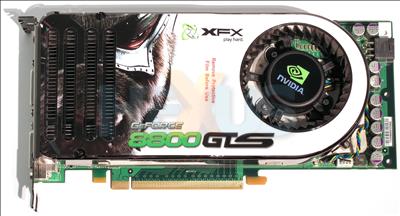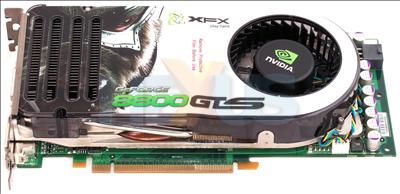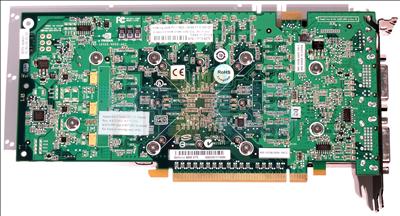XFX XXX Edition 320MiB card appearance and thoughts
It might not seem so on first appearance but this is a brand-new SKU, yessir.
Hiding underneath that ubiquitous heatsink is a GeForce 8800 GTS 320MiB card. NVIDIA's decided to launch a lower-cost SKU in the hope of attracting customers who find the 640MiB's £250+ pricing unpalatable.
We can confirm the only difference between the two GTS SKUs is the framebuffer. Half the framebuffer, amounting to 320MiB, according to NVIDIA, is still more than enough to accommodate the workload presented by modern games without hiccup, even up to 1920x1200. Thus, reducing it - and thereby the associated costs of implementation - should offer, in most cases, near-identical 640MiB performance but at a lower price point.
Physically, the card still uses 10 memory chips but the modules' capacity is halved from 512MBit to 256MBit. Of course, removing half the RAM doesn't impact upon the bus width, which is kept at 320-bit.
Reading between the lines, the 320MiB version won't be as futureproof as the double-sized version, with upcoming games expected to use 500MiB+ of data, yet this compromise should be offset by an attractive street price. NVIDIA, frankly, is giving you a choice between the two, that is, go for the 320MiB version if financial considerations are primary and you're not overly concerned about performance in two years' time. Opt for the 640MiB if you can stretch to the asking price; it will be better in the long run, especially if you play games at high resolutions with high I.Q. levels: a sure-fire method of swamping the framebuffer.
XFX, however, has taken the opportunity presented by the arrival of a new SKU to release another XXX Edition. Formally named the XFX GeForce 8800 GTS 320MB DDR3 XXX Edition, it ships with a core/shader/memory speeds of 580/1500/1800, respectively, making it even more extreme than the 640MiB version. Indeed, the basic frequencies are higher than a default-clocked GeForce 8800 GTX's, but architectural chops to the stream processors and memory interface will ensure sub-GTX performance.
We can confirm that XFX is using 1.1ns memory from Hynix whose native speed is an effective 1800MHz, whereas a stock-clocked 8800 GTS uses 1.2ns GDDR3 with a native speed of 1600MHz.
Saving us from repeating it ad nauseum, you'll already know the pertinent points regarding the DVI ports and the rear of the PCB.
Comparisons
There's a bunch of numbers to digest from the XFX XXX Edition line-up, so here's a table that should make it a little easier.| Card | XFX GeForce 8800 GTS XXX 320MiB | XFX GeForce 8800 GTS XXX 640MiB | ASUS GeForce 8800 GTS 640MiB | Foxconn GeForce 8800 GTX 768MiB |
|---|---|---|---|---|
| Core clock | 580MHz | 550MHz | 513MHz | 575MHz |
| Stream processors | 96 (6x16) | 96 (6x16) | 96 (6x16) | 128 (8x16) |
| Shader clock | 1500MHz | 1500MHz | 1200MHz | 1350Mhz |
| Framebuffer | 320MiB | 640MiB | 640MiB | 768MiB |
| Memory clock | 1800MHz | 1800MHz | 1600MHz | 1800MHz |
| Memory bus width | 320-bit | 320-bit | 320-bit | 384-bit |
| Memory bandwidth | 72GB/s | 72GB/s | 64GB/s | 86.4GB/s |
We expect the 640MiB XXX Edition to outperform the ASUS GTS card; the XFX's clocks are faster. The 320MiB Edition should also be faster in cases where framebuffer sizes don't matter. When they do, we'll investigate the performance degradation of only having a half-sized buffer. [advert]














